Rhododendron or Azalea is a perennial plant that is appreciated by gardeners for lush flowering. It is grown everywhere throughout the Russian Federation, used to decorate garden plots and park areas. Rhododendrons require special care in the fall, preparation for winter includes not only restrictions on watering and top dressing, but also pruning, which ensures mass flowering in season. Caring for a plant is easy if you know the key rules.
Content
Rhododendron or Azalea - a brief description of the flower
Rhododendron is a low shrub with dark bark, whose branches reach a length of 2-4 meters. Young shoots are covered with iron-lowered scales, which disappear for 4 years. The leaves are alternate, with petioles, whole-edge, their length 2 cm in a young plant and 8 cm in a mature shrub. The sheet has an elliptical shape, tapers to the base, the edges fold down.
The decorative value of a plant is its flowering. Flowers have a long peduncle and are collected at the end of a branch in a bouquet of 3-5 buds. Corolla - irregular, reaches 5 cm in diameter, light yellow with a wide funnel and 5 blades. The flower has 10 stamens of different lengths. The plant propagates by seeds, they are small, ripen in late August. Growing an adult bush from seeds under normal conditions is difficult. Azalea has a pronounced, pleasant smell of green strawberries.
Azalea garden belongs to the Vereskov family. This genus is represented by shrubs and trees, deciduous, semi-deciduous and evergreen plants. The genus has more than 1000 species.
In wild conditions, the plant is common in such regions:
- Southeast Asia;
- Japan;
- America;
- South China
- Himalayas.
Shrubs grow well near the seas, oceans, on the slopes of the mountains. Prefer partial shade. Flowers of different species of this genus differ in color, but also in size, shape.
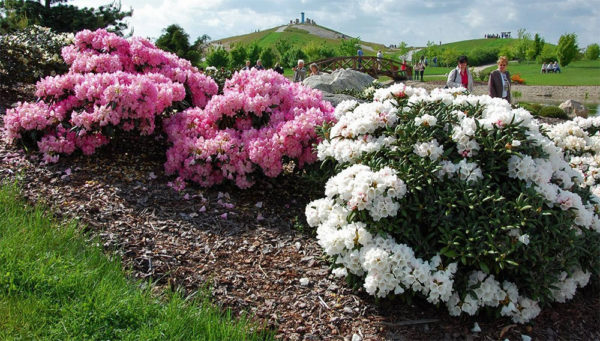
How to prepare for wintering
Flowering shrubs need care not only during the period of active growth, flowering, but also in autumn. The intensity of growth, the abundance of flowering plants in the next season depends on how rhododendron winters. First-year shrubs require reverent care. If the plant belongs to the category of evergreens, it requires year-round watering, because their foliage evaporates moisture. Despite the fact that Azalea is a delicate flower, breeders have bred varieties that successfully tolerate a decrease in temperature to -35 degrees.
Pruning
To ignore the need for regular, annual pruning of evergreen shrubs is not worth it. Broken and frozen shoots must be removed. They do not easily spoil the view, but can become sources of pathogenic infection, causing damage to the plant and entailing its complete death.
With proper care, damage to the shoots is rare, but this is not a reason to endure pruning. Anti-aging pruning is a guarantee for lush flowering next year. It helps form the crown of a bush. The procedure can be carried out in spring or autumn, the optimal period is determined depending on the variety.
There are 3 types of pruning:
- sanitary - carried out at any time of the year, rotten, damaged shoots are removed, included in the range of mandatory measures before wintering;
- formative - carried out in spring or autumn, cut shoots to form a homogeneous crown;
- anti-aging - spend 1 time in 3 years, remove the old shoots to stimulate the growth of new ones, without observing such conditions, the bush will not bloom.
With sanitary pruning, only damaged branches are removed to healthy sites. In deciduous plants, the bark is damaged in winter, because it is also cut to living tissue. Anti-aging pruning is a total haircut, suggesting the removal of 60% of the branches. The volume of shoots removed during the forming haircut is changed at the discretion of the gardener. Manipulation is carried out by sharpened secateurs, so as not to damage the bark.
Pruning in the fall is carried out 2 weeks before the expected onset of the first frost, therefore, it is impossible to indicate its date. Recommendations vary by region. In outskirts of Moscow Azalea should be cut in early October. Slicing places must be processed.
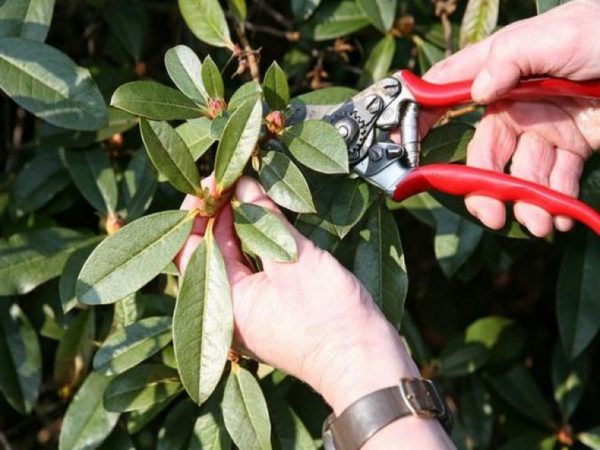
Watering
Rhododendron is a moisture-loving plant that is acutely related to a lack of moisture, especially at a young age. In the first year after planting, you need to control soil moisture not only in summer but also in winter. It is not necessary to fill in the bush, the humidity regime needs to be adjusted. Excess water will cause rotting of the fragile root system.
Attention is paid not only to the process of irrigation, but also to the quality of the water used - it should be soft. Suitable rain, melt or typed in a clean pond. If the autumn is dry, the bush is additionally sprayed. You can determine the lack of moisture on the sheet, it becomes dull and wilts. Brown spots appear on its edges, resembling a fungal infection. The main rule of watering is regularly, but in small volumes.
Top dressing
For the organization of top dressing in the autumn, mineral and organic fertilizers are used. Mineral include: phosphorus and potassium, and organic include bone meal, manure, pine needles and peat. Experienced growers recommend mixing them. Since the root system of the plant is close to the soil, feed material must be dissolved in water before being introduced into the soil.
Azalea loves acidic soil, because for fertilizer they use mineral components that meet this indicator. Superphosphate optimizes bud budding, magnesium sulfate replenishes the lack of trace elements in the soil, potassium sulfate accelerates the maturation of bark on the shoots of shrubs. It is forbidden to use fertilizers containing chlorine, they will destroy the azalea.
Rotted manure is used to improve soil fertility and increase moisture permeability. Bone meal helps make up for the lack of trace elements in the soil and provides plant nutrition for a long time. Organic fertilizers do not have to be added to the soil with water, they can be scattered on the ground in a circle around the plant trunk. Thus, they are fed carefully using a small amount of organic matter.
In winter, the plant is not fed.The last feed is carried out before the onset of frost. After freezing, the plant is watered if there is no snow cover. When soil freezes, watering is canceled.
Disease and Pest Treatment
Often, after wintering, azalea looks unhealthy due to non-infectious lesions, manifested due to winter drying or soaking. It is also possible the manifestation of signs of infectious lesions of a fungal nature.
Winter drying appears after a long winter with strong and prolonged frosts. At the same time, the leaves of Rodondendron remain twisted in the spring, despite the positive temperature. Such symptoms indicate that the leaves of the plant in winter lost all moisture. The grower must restore the circulation of water in the soil. To do this, water the plant and spray it 2 times a day after thawing the soil. It is quite difficult to prevent the occurrence of a problem; proper hiding helps to partially improve the forecast.
On the contrary, excessive soil moisture leads to extinction. The sheet becomes gray-green, dull, falls off for no apparent reason. Often, wetting occurs if proper drainage is not arranged and the mulching of the earth is not ensured. The plant needs to be transplanted to a new place.
A seedling can die from fungal infections:
- Fusariosis - root damage occurs, the movement of nutrients in the vessels is disturbed. The leaves fade and turn brown, a plaque appears on the root neck. It is better to isolate a bush from other plants and to process with Fundazol.
- Alternariosis - red spots appear on the leaves. For treatment, Broads acid is used.
- Phyllocystosis - brown spots framed by a brown border appear on the leaves. The middle of the leaf dries out and gets enough sleep. The affected parts are removed, and healthy areas are treated alternately with a working solution of Topsin and Fundazole.
- Cecrosporosis - brown spots occur on the back of the plate. The sheet is covered with a gray coating on top. Fungicides are used for treatment.
Various pests provoke azalea diseases, but the gardener encounters them during the growing season. Before wintering, the bush should be carefully examined for the presence of larvae of aphids, whiteflies, slugs and thrips. If there are signs of damage, you need to conduct treatment with Actelik or Aktara.
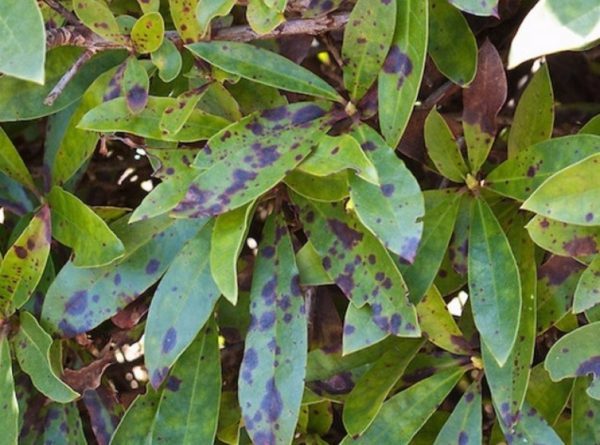
Mulching
Azalea has a superficial root system, so freezing of the underground part is the most common cause of spring death of the plant. The bush must be mulched before the onset of cold weather. To do this, use a mixture of pine needles and horse peat - this composition also provides food in the winter.
If the plant has a height of more than one meter, spread the mulch with a slide, the height of which reaches 30-35 cm. It is better to cover the entire area of the earth near the roots, ideally - the mulch is laid on the entire area of the earth under the bush.
Many gardeners make the common mistake of using fallen azalea leaves for mulching. It is absolutely impossible to do this, because they can be sources of bacteria and fungi. View each sheet before use - it is impossible, because they must be discarded.
Shelter
Rhododendron tolerates minor frosts well. Therefore, it is necessary to cover it for the winter after the onset of steady colds - the average temperature per day should be at least 10 degrees. Early shelter will create conditions for the formation of condensate, leading to decay of the root neck of the plant.
Frost-resistant, deciduous varieties tolerate impressive frosts well up to 35 degrees, because before wintering they are simply pruned, treated for diseases and mulched soil. Shelter is required only by young plants planted this year. For shelter use burlap or cardboard, the main condition for choosing a material is its breathability.
Non-frost-resistant varieties wintering with green should be covered even in regions with relatively high temperatures in winter. Such a rhododendron does not tolerate a temperature drop of more than -10 degrees.
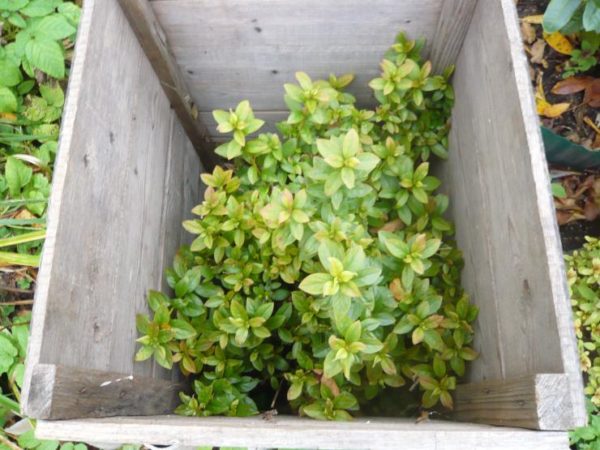
Care by region: table
A winter-resistant plant can be grown in all regions of Russia, but the principles of care may vary slightly. The table contains the main recommendations.
| Type of work | Regions of Russia | |||
| Middle lane | Leningrad region | Siberia | Ural | |
| Pruning | Can be carried out in autumn and spring. Autumn is carried out before the onset of frost. | Spend 2 weeks before the expected frosts, in the spring - after stabilization of the plus temperature. | Exclusively in spring after the complete removal of snow cover. | Only in spring, pruning before wintering weakens the azalea, and it can die with a significant decrease in temperature, regardless of shelter. |
| Watering | Watered before applying mineral fertilizers, if the autumn is not rainy. | Often watering is not required due to the high humidity in the region. | Until the air temperature drops. | Watering in autumn and winter is not required. |
| Top dressing | It is carried out 2 weeks before the onset of frost. | |||
| Pest treatment | After top dressing. | |||
| Soil mulching | Mulch is laid in a layer up to 10-15 cm. | Mulch is placed when the temperature drops to -10 degrees with a layer of up to 20 cm. | The roots cover the mulch as much as possible. Material is spread over the entire surface under the plant. The height of the embankment should be at least 25 cm for frost-resistant varieties and more than 35 for evergreen. | |
| Shelter | Deciduous varieties can winter without shelter, evergreens require simple protection from the cold, for example, wrapping burlap or building primitive protective structures. | Frost-resistant varieties dropping leaves in the fall are wrapped in dense, breathable material. Evergreen varieties are difficult to tolerate winter in Siberia and the Urals, therefore it is recommended to use methods of maximum warming. It is recommended to build a shelter according to the type of hut using fir spruce branches. | ||
The rules of care during the growing season of rhododendron do not change by region. The plant requires regular watering, additional spraying, top dressing, timely removal of faded buds.
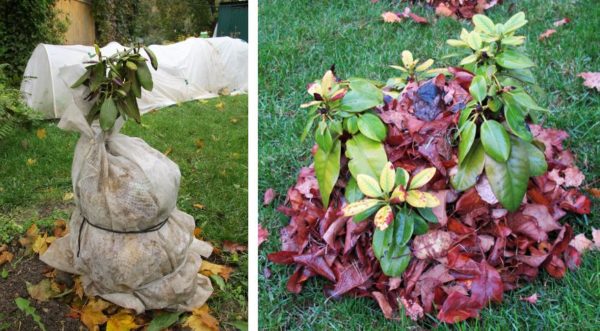
Life cycle features
Depending on the variety, the plant may be:
- Deciduous. In autumn, it loses all the leaves, and in the spring it again increases leaf mass. Differs in frost resistance and unpretentiousness.
- Semi-deciduous. Loses green mass 1 time in 2 years.
- Evergreen. Does not drop leaves after the growing season. Varieties are non-frost resistant. Because they need to be carefully sheltered for the winter, even in the suburbs.
How to insulate each type of azalea garden
Azalea is more sensitive to lack of moisture than to severe cold, therefore it is important to protect the plant from dehydration. Key recommendations for species common in Russia:
- Deciduous. The bush reaches a height of 1.5, therefore, before wrapping up the branches are bent to the ground and sprinkled with leaf mixture or peat.
- Japanese rhododendron. It is distinguished by dwarfism, its height is up to 50 cm, therefore it is convenient to cover it with cardboard or burlap after a cold snap to -10.
- Evergreen.Young bushes are covered with spruce spruce branches even in the south of Russia. Adult shrubs tolerate lower temperatures, because shelter rhododendron for the winter needed in the suburbs and in the Urals.
- Multifloral azalea. The plant is not afraid of a slight cooling. After lowering the temperature to -10, a frame is constructed from the boards and wrapped with a breathable, non-woven material.
Gardeners recommend sheltering any kind of azalea for the winter, because the plant can be badly damaged by wind, not frost. Winter without snow is dangerous for her.
Shop constructions
If there is no opportunity to build a shelter for rosewood on your own or do not allow the opportunity, you can buy ready-made. Often such designs are a frame, accompanied by a special covering material. It is convenient to use the device - it is simply installed at the right time and removed in the spring, after stabilization of the temperature.
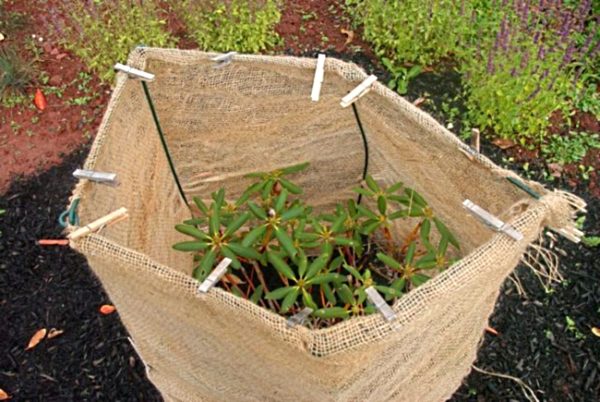
Self-creation
To make the frame, you will need tools:
- screwdriver;
- screws;
- hacksaw;
- jigsaw;
- saw.
For the frame, boards or timber are used, and covering material will also be required.
Construction Instruction:
- The frame is made of boards or timber fastened in a wigwam format.
- The height must be calculated so that the structure is 20 cm above the branches.
- The material is pulled onto the frame so that the cover lies on the ground.
- The cover is spread out on the soil and applied with bricks.
Next way:
- A stool is made of wood and metal.
- The lid is made of sawdust pressed into a timber.
- The design is covered with litrasil, its edges are pulled to the ground.
The disadvantage of the structural solution is that, thus, only a low plant can be insulated.
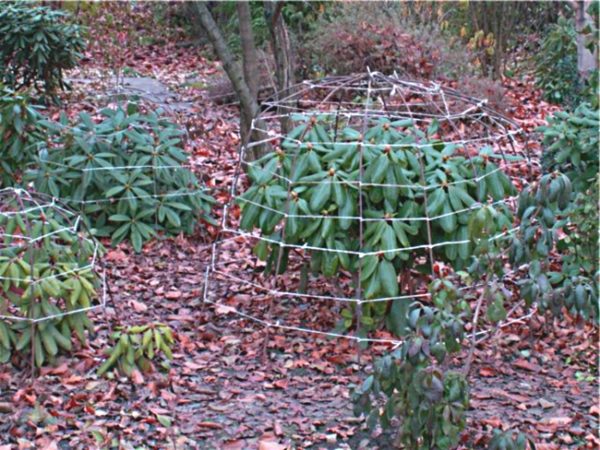
The easiest method:
- In a cardboard box, small holes are made for ventilation.
- Install the structure on the bush and cover with breathable material.
- The edges of the material stretch along the ground.
The method is suitable for adult plants with a height of up to a meter.
Closing instruction
In general, the closing process includes:
- watering is stopped late in the fall, before the onset of freezing;
- fertilize rhododendron with a potassium and magnesium composition;
- conduct forming pruning;
- treated against fungus and pests;
- arrange mulching;
- if the bush is tall, its branches bow to the ground;
- take cover according to the selected method.
Wintering ends in early March, after an increase in ambient temperature.
Dates when to carry out work
The optimal terms for creating a shelter and its elimination depending on the region are described in the table:
| Process | The middle strip of Russia, Moscow region, Ukraine | Leningrad region | Siberia | Ural |
| The beginning of wintering | November | November | End of September - beginning of October | The end of October |
| Awakening | March | March | Mid april | Beginning of april |
The dates given are indicative, that is, the gardener should clarify the weather forecaster's forecast and take it into service. If, according to the forecast, the onset of winter is promised early, it is necessary to have time to carry out all the work up to this point.
Main problems
Often, gardeners deviate from existing recommendations for caring for the plant, and therefore face difficulties. With early shelter, the root system warms up. Because natural air exchange is disturbed. An adult plant can survive this violation of the regime, but you should not expect flowering and rapid growth in the next season. A young plant will definitely die, so you do not need to worry about autumn frosts - a slight decrease in temperatures is not so dangerous.
Late shelter should not be allowed. Dangerous sudden freezing of excessively moist soil, because the roots of the plants are in the "ice trap."Freezing leads to the development of rot of the root system and death of the plant. Such a bush can be saved in the spring, but it is very difficult.
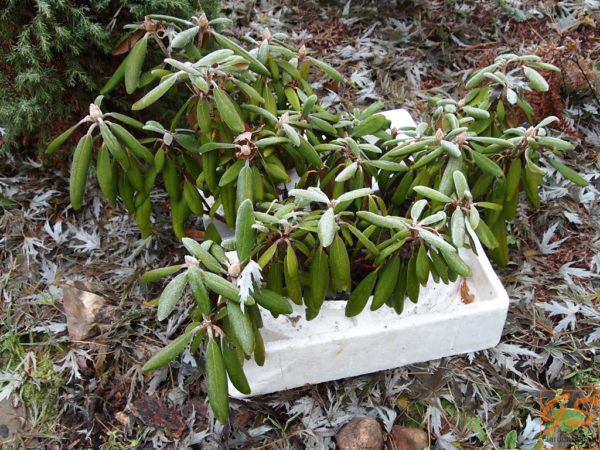
Mistakes
When growing azaleas in open ground, even experienced growers make serious mistakes:
- Improper soil preparation - the bush grows well only in acidic soil. High acidity leads to chlorosis.
- Unregulated humidity conditions. Drying of an earthen coma and overflow is dangerous for a plant. It should be watered as the top layer of the soil dries. Good drainage is needed.
- Lack of light or its excess. With a lack of light, the shoots of the bush are stretched, and flowering is absent. Excessive sunshine leads to burns, so you need to have azalea in a moderately lit area.
- Lack of nitrogen. Shrubs require generous fertilizing with nitrogen fertilizers, like other flowering plants.
- Damage to shoots by wind and snow. Reliable shelter for the winter helps to avoid this problem.
It is easier to prevent the occurrence of such problems than to eliminate their consequences later. It often happens that it is impossible to save a young bush due to the carelessness of a specialist.
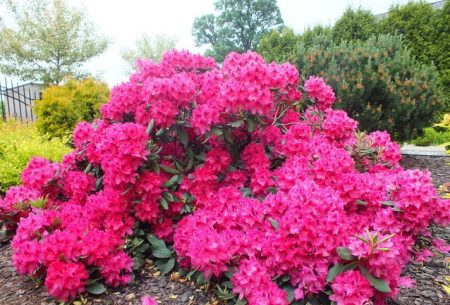 You may be interested in:
You may be interested in:Advice to those who do not shelter rhododendron for the winter
Rhododendron, which is not sheltered for the winter, may be affected by direct sunlight. This can be prevented by constructing a shield and securing it in early March from the south side. In winter, you need to control the condition of the shrub, it can break the wind, the shoots can be covered with ice.
Finally
Garden azalea can be called the second queen of flowers, after a rose. This plant has its own “character”, therefore it is necessary to find a special approach to it, if everything is done correctly, it will give the gardener rapid flowering and bright greenery.

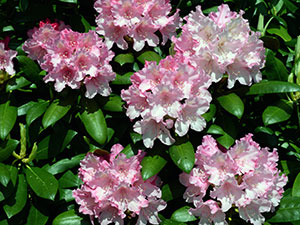 Rhododendrons in the suburbs - how to care and plant?
Rhododendrons in the suburbs - how to care and plant?